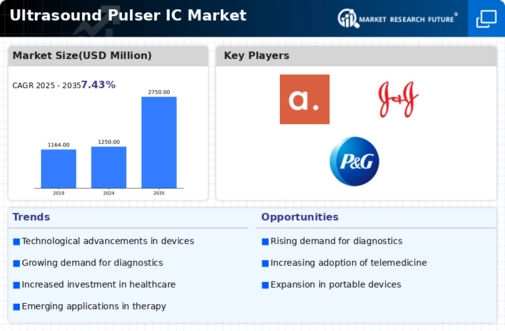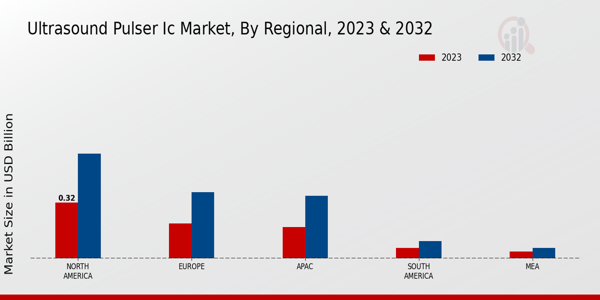Expansion of Telemedicine
The expansion of telemedicine services is emerging as a pivotal driver for the Global Ultrasound Pulser IC Market Industry. As healthcare providers increasingly adopt remote consultation models, the need for portable and efficient ultrasound devices is growing. Telemedicine facilitates access to ultrasound diagnostics in remote areas, where traditional imaging facilities may be limited. This shift is likely to spur demand for compact ultrasound systems equipped with advanced pulser ICs, enabling high-quality imaging in diverse settings. The market's growth trajectory is supported by the increasing integration of ultrasound technology into telehealth platforms, which enhances patient care and expands the reach of medical services.
Market Growth Projections
The Global Ultrasound Pulser IC Market Industry is projected to experience substantial growth, with estimates indicating a market value of 1250 USD Million in 2024 and a remarkable increase to 2750 USD Million by 2035. This growth reflects a compound annual growth rate (CAGR) of 7.43% from 2025 to 2035. Such projections highlight the increasing adoption of ultrasound technology across various sectors, including healthcare, automotive, and industrial applications. The rising demand for high-performance ultrasound systems is expected to drive innovation in pulser IC designs, further contributing to the market's expansion. These figures underscore the potential for significant advancements and investments in the ultrasound sector.
Technological Advancements
The Global Ultrasound Pulser IC Market Industry is experiencing rapid technological advancements, which enhance the performance and efficiency of ultrasound systems. Innovations in integrated circuit design and materials are leading to improved signal quality and reduced power consumption. For instance, the introduction of high-frequency pulser ICs allows for better resolution in imaging applications. As a result, the market is projected to reach 1250 USD Million in 2024, driven by the demand for more sophisticated medical imaging devices. These advancements not only improve diagnostic capabilities but also expand the applications of ultrasound technology in various fields, including industrial and automotive sectors.
Regulatory Support and Standards
Regulatory support and the establishment of industry standards are crucial factors driving the Global Ultrasound Pulser IC Market Industry. Governments and health organizations are implementing guidelines that promote the safe and effective use of ultrasound technology in medical diagnostics. Compliance with these regulations encourages manufacturers to invest in research and development, leading to the creation of innovative pulser ICs that meet stringent quality standards. This regulatory framework not only fosters market growth but also enhances consumer confidence in ultrasound devices. As the industry evolves, adherence to these standards will likely play a vital role in shaping the future of ultrasound technology.
Increasing Healthcare Expenditure
Rising healthcare expenditure globally is a significant driver for the Global Ultrasound Pulser IC Market Industry. Governments and private sectors are investing heavily in healthcare infrastructure, which includes upgrading medical imaging equipment. This trend is particularly evident in emerging economies, where healthcare budgets are expanding to improve access to advanced medical technologies. The market is expected to grow as hospitals and clinics seek to acquire state-of-the-art ultrasound systems, contributing to an anticipated market value of 2750 USD Million by 2035. Increased funding for healthcare initiatives is likely to stimulate demand for ultrasound pulser ICs, thereby enhancing diagnostic accuracy and patient outcomes.
Growing Demand for Non-Invasive Procedures
The growing preference for non-invasive diagnostic procedures is significantly influencing the Global Ultrasound Pulser IC Market Industry. Patients and healthcare providers favor ultrasound imaging due to its safety, cost-effectiveness, and lack of radiation exposure compared to other imaging modalities. This trend is particularly relevant in obstetrics and cardiology, where ultrasound plays a crucial role in monitoring fetal development and cardiac conditions. As the demand for non-invasive techniques continues to rise, manufacturers are likely to innovate and enhance their ultrasound pulser IC offerings, further driving market growth. The increasing adoption of ultrasound technology in various medical fields underscores its importance in modern healthcare.














Leave a Comment